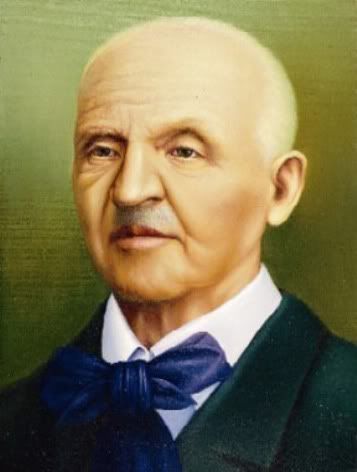Anton Bruckner

His Life
Anton Bruckner was born in Ansfelden, Austria in 1824 to a schoolmaster and organist father with whom he first studied music. He worked for a few years as a teacher's assistant, fiddling at village dances at night to supplement his income. He studied at the Augustinian monastery in St. Florian, becoming an organist there in 1851. He continued his studies to the age of 40, under Simon Sechter and Otto Kitzler, the latter introducing him to the music of Richard Wagner, which Bruckner studied extensively from 1863 onwards. Soon after ending his studies, he wrote his first mature work, the Mass in D Minor. He was a very devout Roman Catholic.
In 1868 he accepted a post as a teacher of music theory at the Vienna Conservatory. At this point he concentrated most of his energies on writing symphonies. However these symphonies were poorly received, considered "wild" and "nonsensical". He later accepted a post at the Vienna University in 1875. Overall, he was quite unhappy in Vienna, musically dominated by the critic Eduard Hanslick. At that time there was a feud between those who liked Wagner's music and those who liked Brahms's music. By aligning himself with Wagner, Bruckner made an enemy out of Hanslick without wanting to. He did have supporters, famous conductors such as Artur Nikisch and Franz Schalk, who were constantly trying to bring his music to the public, and for this purpose proposed many 'improvements' for making Bruckner's music more acceptable to the public, and while Bruckner allowed these changes, he also made sure in his will to bequeath his original scores to the Vienna National Library, confident of their musical validity. Another proof of Bruckner's confidence in his artistic ability is the fact that he often started work on a new Symphony just a few days after finishing another.
In addition to his symphonies, Bruckner wrote Masses, motets, and other sacred choral works. Unlike his highly romantic symphonies, Bruckner's choral works are often quite conservative and contrapuntal in style.
Bruckner was a renowned organist in his time, impressing audiences in France in 1869, and England in 1871, giving six recitals on a new Henry Willis organ at Royal Albert Hall in London and five more at the Crystal Palace. But he wrote no major works for the organ. His improvisation sessions sometimes yielded ideas for the Symphonies. He also taught organ performance at the Conservatory. One of his students was Hans Rott, whose music greatly influenced Gustav Mahler.
Bruckner died in Vienna on October 11, 1896, and his Ninth Symphony premiered in the same city on February 11, 1903. He was never married, though he proposed to a large list of astonished young women. He had a morbid interest in dead bodies, and left extensive instructions that his own was to be embalmed.
His Music
The Symphonies
Bruckner's Symphonies are all in four movements, starting with a modified sonata form allegro, a slow movement, a scherzo and a modified sonata form allegro finale. They are scored for a fairly standard orchestra of woodwinds in pairs, four horns, two or three trumpets, three trombones, tuba, timpani and strings. The later symphonies increase this complement, but not by much.
Otto Kitzler, Bruckner's last composition teacher, set him three final tasks as the climax of his studies: a choral work, an overture, and a symphony. The latter, completed in 1863 was then Bruckner's Study Symphony in F minor, also known as the 00th. Bruckner later rejected this work, but he did not destroy it. While it certainly reminds one of earlier composers such as Robert Schumann, it undeniably also bears the hallmarks of the later Bruckner style, especially in the parts of the first movement where the trumpet dominates and in the scherzo. The finale is perhaps a bit weak, but overall the work promised many riches to come, though unfortunately Kitzler was not able to see these and simply commented that the work was "not very inspired". It was first performed in 1924 and not published until 1973.
Bruckner's Symphony No. 1 in C minor was completed in 1866, but the original text of this symphony was not reconstructed until 1998. Instead, it is commonly known in two versions, the so-called Linz Version which is based mainly on rhythmical revisions made in 1877, and the completely revised Vienna Version of 1891, which in some ways starts to sound like Symphony No. 8.
Next was the so-called Symphony No. 0 in D minor of 1869, a very charming work which unfortunately was so harshly criticized that Bruckner retracted it completely, and it was not performed at all during his lifetime. The scherzo especially seems to have a raw power which sometimes seems missing in later works which had undergone more revisions.
The Symphony No. 2 in C minor (apparently one of Bruckner's favourite keys), which was revised in 1873, 1876, 1877 and 1892. Sometimes called the Pause Symphony for its dramatic use of whole-orchestra rests, very nicely accentuating the form. In the Carragan edition of the 1872 version, the Scherzo is placed second and the Adagio third.
Symphony No. 2 in C minor
Georg Tintner conducting the National Symphony Orchestra of Ireland
Bruckner presented the Symphony No. 3 in D minor, written in 1873, to Wagner along with the 2nd, asking which of them he might dedicate to him. Wagner chose the 3rd, and Bruckner sent him a fair copy soon later, which is why the original version of this Wagner Symphony is preserved for us so nicely despite revisions in 1874, 1876, 1877 and 1888/89. One thing that helped Wagner choose which Symphony to accept the dedication of was that the 3rd contains quotations from Wagner's music dramas, such as Die Walküre and Lohengrin. Some of these quotations were taken out in revised versions. Gustav Mahler and Rudolf Krzyzanowski made a piano duet version of this Symphony.
Bruckner's first great success was his Symphony No. 4 in E flat major, more commonly known as the Romantic Symphony. The success, however, was not immediate, but came only after major revisions in 1878, including a completely new scherzo and finale, and again in 1880/1881, once again with a completely rewritten finale. Even despite the great success of the first performance in 1881 (under the conductor Hans Richter), Bruckner made some more minor revisions in 1886-1888. The 1874 version is interesting to listen to despite being somewhat repetitive.
Finally, Bruckner's Symphony No. 5 in B flat minor crowns this productive era of symphony-writing, finished at the beginning of 1876. Unfortunately the original version seems unrecoverable and we know only the thoroughly revised version of 1878. Many consider this symphony to be Bruckner's lifetime masterpiece in the area of counterpoint. For example, the Finale is a combined fugue and sonata form movement.
Symphony No. 6 in A major, written in 1879-1881, is an oft-neglected work. Whereas the Bruckner rhythm (3+2) is completely absent from the previous Symphony, in this one it permeates everything, appearing in the first movement in multiple simultaneous instances overlaid in divergent patterns resulting in rhythmic complexity. Perhaps the rhythmic difficulties of this work, especially in the first movement, are part of the reason why this work is so seldom played.
The most beloved of Bruckner's symphonies with audiences of the time, and still popular today, is Symphony No. 7 in E major. It was written 1881-1883 and revised in 1885. During the time that Bruckner began work on this Symphony, he was aware that Wagner's death was imminent, and so the Adagio is slow mournful music for Wagner, and for the first time in Bruckner's oeuvre, the Wagner tuba is included in the orchestra. There's also a legend that Bruckner wrote the climactic cymbal clash in this movement at the precise moment that Wagner died. Arnold Schoenberg made a chamber ensemble version of this work.
Symphony No. 7 in E major
Karl Bohm conducting the Vienna Philharmonic
Bruckner began composition of his Symphony No. 8 in C minor in 1884, but it did not reach its first complete form until 1887. And when Bruckner then sent it to Hermann Levi, the conductor who had lead his 7th to great success, the latter did not understand this very different work at all and utterly rejected it, almost driving Bruckner to suicide. But instead he set to work thoroughly revising the symphony, sometimes with the 'aid' of Franz Schalk, and completed this new version in 1890. In the first version, the first movement ends fortissimo, as is usual in all other Bruckner Symphonies, but in the revision, Bruckner ended the first movement pianissimo, which is more dramatic given the content of the music. Also, he made the Scherzo less repetitious, changed some tonal areas in the Adagio and trimmed the cymbal part, and changed the ending of the Finale.
The final accomplishment of Bruckner's life was to be his Symphony No. 9 in D minor, which he started in 1887. The first three movements were completed at the end of 1894, but by the time of his death in 1896, he had not finished the last movement, but he left extensive sketches. There have been several attempts to complete these sketches and prepare them for performance, and perhaps the more successful, scholarly attempts are those by John A. Phillips's team and the one by William Carragan. Bruckner wrote down his music in a very methodical manner that allows musicologists to form a very clear idea of what Bruckner had in mind and create performing versions that sound very much like Bruckner. Bruckner suggested using his Te Deum as a Finale, which would complete the homage to Beethoven's 9th symphony (also in D minor), but he was intent on completing the Symphony. Nowadays just the first three movements of the Symphony are performed most of the time, but there are recordings of the attempts at reconstructing the Finale are worth listening to.
Symphony No. 9 in D minor
Carlo Maria Giulini conducting the Vienna Philharmonic
Sacred Choral Works
Bruckner wrote numerous vocal and orchestral pieces for church performance, including three Masses in the 1860s, a Te Deum, settings of various Psalms, (including Psalm 150 in the 1890s) and various motets such as Ave Maria, Ecce Sacerdos Magnum, Locus iste, etc.
Other Music
As a young man Bruckner sang in men's choirs and he also wrote a lot of music for them. This music is rarely played nowadays. Biographer Derek Watson characterises the pieces for men's choir as being "of little concern to the non-German listener". Of thirty such pieces, Helgoland is the only secular vocal work Bruckner thought worth bequeathing to the Vienna National Library.
Bruckner never wrote an opera, because he wanted a libretto "entirely free of all that is impure." That rules out most opera libretti.
He also wrote some quaint Lancer-Quadrille for piano.
The Overture in G minor was occasionally included in recordings of the Symphonies.
A String Quartet in C minor was discovered decades after Bruckner's death, but it's only of interest as a student composition. The later String Quintet in F major, contemporary of the Fifth and Sixth Symphonies, is sometimes recorded and performed nowadays.
